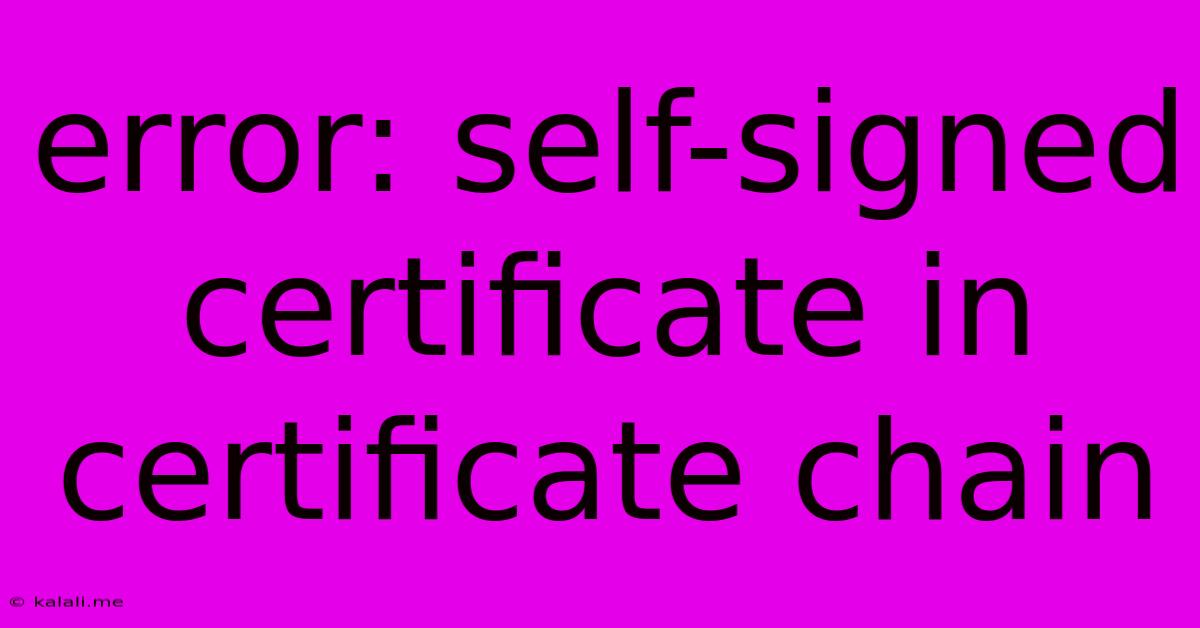Error: Self-signed Certificate In Certificate Chain
Kalali
May 30, 2025 · 4 min read

Table of Contents
Error: Self-Signed Certificate in Certificate Chain: Understanding and Resolving the Issue
The dreaded "self-signed certificate in certificate chain" error. This cryptic message often pops up when browsing secure websites (HTTPS), indicating a problem with the website's security certificate. This article will explain what this error means, why it happens, and how you can resolve it. Understanding this error is crucial for both website owners and users.
What is a Self-Signed Certificate?
Before diving into the error, let's understand what a self-signed certificate is. Normally, websites obtain security certificates from trusted Certificate Authorities (CAs) like Let's Encrypt, DigiCert, or Comodo. These CAs verify the website's identity and issue a digital certificate guaranteeing its authenticity. A self-signed certificate, however, is created and signed by the website owner themselves, bypassing the verification process of a trusted CA.
Why Does the "Self-Signed Certificate" Error Occur?
The error arises because your browser doesn't trust the self-signed certificate. Your browser relies on a list of trusted CAs. Since a self-signed certificate isn't issued by one of these trusted authorities, your browser flags it as untrusted, posing a potential security risk. This is a crucial security measure to protect you from fraudulent websites impersonating legitimate ones.
Common Scenarios Leading to the Error:
- Development Environments: Developers often use self-signed certificates for testing purposes on local servers or during the development phase of a website. This is perfectly normal in a controlled environment, but the error will appear when accessing the site from outside that environment.
- Internal Networks: Companies might use self-signed certificates for internal websites accessible only within their private network. These certificates are not meant for public access.
- Misconfigured Servers: Sometimes, a server might be incorrectly configured to use a self-signed certificate even when it should be using a certificate from a trusted CA.
- Outdated Certificates: While not directly a self-signed issue, an expired certificate might trigger similar error messages.
How to Resolve the "Self-Signed Certificate" Error:
The solution depends on whether you're a website user or a website administrator.
For Website Users:
- Understand the Risk: Accessing websites with self-signed certificates carries inherent risks. Proceed with caution and only do so if you completely trust the source.
- Add the Certificate as an Exception (Proceed with Caution): Most browsers allow you to add an exception for a self-signed certificate. This means you're explicitly telling your browser to trust this specific certificate, despite it not being from a trusted CA. This is risky and should only be done if you understand the implications. This process varies slightly depending on your browser (Chrome, Firefox, Edge, Safari), but generally involves accepting a warning and confirming the exception. Use this option only if you completely trust the website.
- Contact the Website Administrator: If you encounter this error on a website you should be able to access, inform the administrator about the issue. They should install a certificate from a trusted CA.
For Website Administrators:
- Obtain a Certificate from a Trusted CA: This is the recommended and most secure solution. Services like Let's Encrypt provide free SSL certificates. This ensures your website is trusted by browsers and protects users from potential security risks.
- Configure Your Server Properly: Ensure your web server (Apache, Nginx, IIS) is correctly configured to use the certificate obtained from a trusted CA.
- Use Self-Signed Certificates ONLY for Development or Internal Use: Remember, self-signed certificates are suitable only for local testing or internal networks with controlled access. Never use them for public-facing websites.
Preventing Future Occurrences:
- Regularly Update Certificates: Keep your website's certificates updated to avoid expiry issues.
- Proper Server Configuration: Ensure your server is correctly set up to handle SSL certificates.
- Secure Development Practices: For development, utilize secure practices and only use self-signed certificates within isolated, controlled environments.
The "self-signed certificate in certificate chain" error is a critical security warning. Understanding its cause and implementing the appropriate solution is essential for both website users and administrators to maintain a secure online environment. Always prioritize security best practices and obtaining certificates from trusted CAs for public-facing websites.
Latest Posts
Latest Posts
-
Check Size Of Photos On Mac
May 31, 2025
-
How Do You Measure Punching Power
May 31, 2025
-
Car Heat Blows Hot Then Cold
May 31, 2025
-
What Type Of Christian Am I
May 31, 2025
-
How Do I Turn Off Itunes
May 31, 2025
Related Post
Thank you for visiting our website which covers about Error: Self-signed Certificate In Certificate Chain . We hope the information provided has been useful to you. Feel free to contact us if you have any questions or need further assistance. See you next time and don't miss to bookmark.